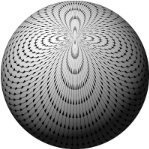

exchemist
Senior Members-
Posts
3730 -
Joined
-
Last visited
-
Days Won
57
exchemist last won the day on July 16
exchemist had the most liked content!
Profile Information
-
Location
London
-
Interests
Rowing, choral singing, walking.
-
College Major/Degree
Chemistry MA, Oxford
-
Favorite Area of Science
chemistry
-
Biography
Trained as a patent agent, then gave it up and worked for Shell, in the lubricants business for 33 years. Widowed, with one teenage son.
-
Occupation
Retired
Recent Profile Visitors
9876 profile views
exchemist's Achievements

Scientist (10/13)
858
Reputation
-
Not sure. If the microwaves are of the right frequency range, they should stimulate rotations of the molecule and cause further heating. But I remember learning that in normal use in a microwave oven it is liquid water they heat, where rotations are quenched by hydrogen bonding, so it may be that the frequency used needs to be different from the one corresponding to the absorption frequency of gas phase rotations. But perhaps someone else here will know.
-
I resort to going down backwards, for 100m or so, every so often. It makes me look a bit of a fool but at my age who cares? It seems to redistribute the synovial fluid, or in some other way destress the joint or allow the moving parts to shift a bit. I was amused to find, descending Ben Arthur (The Cobbler) in Argyll a few years ago, a 25yr old girl doing exactly the same thing, for the same reason. We compared notes on our dodgy knees, which is how I found out she was 25. Pyramid Peak doesn't ring a bell, but looking it up I see there is in fact a cable car to near the top of The Whistlers, which certainly does ring a bell. So I think that was the one.
-
I think I once visited Jasper - car trip from Banff, on a road that passed the foot of the Athabasca glacier, as I recall - and climbed a mountain there that has a cable car to the top, which I rode down, as I tend to suffer from what is known in the family as DKF (Downhill Knee F---), when descending mountains. Any idea what that mountain is called, if my memory of this makes sense? Seem to recall being told to make plenty of noise on the way up, to alert any bears to my presence, which was interesting, for a Brit like me, used mainly to Scottish mountains.
-

2024 Presidential Election: Who should replace Joe Biden?
exchemist replied to Alex_Krycek's topic in Politics
.....which she is not being slow to point out! My worry with her is she doesn't actually seem to be that good at inspirational speaking - perhaps like our own new PM, Starmer, also a former advocate, who is good at forensic analysis and cross-questioning to expose weaknesses in an opponent, but not possessed of high flights of oratory, like an Obama, say. I'm relieved she is starting to articulate a +ve vision of what she stands for, which seems to be loosely all around personal freedom. This can link things together like reproductive rights with the partisan control of the state envisioned in the deeply sinister Project 2025 and freedom from fear, as offered by better gun control (Exhibit B: Trump's ear?). So she does now seem to have more to say than just -ve attacks on Trump. Actually projecting something positive and a bit of happiness will be a real contrast with the permanently angry and abusive, self-centred negativity of Trump. So I'm crossing my finger she can make it. The whole of Europe is desperately hoping Trump loses, as our future as free countries at peace may be in the balance. (Have you seen that Russia has just sabotaged the French railway network, via 5 separate, simultaneous attacks on signalling and cabling at critical railway junctions, to try to turn the Olympics into chaos? The French arrested one Russian agent last week, but evidently there are more of them at large. More here: https://www.bbc.co.uk/news/articles/c28eyr3y18yo) -

2024 Presidential Election: Who should replace Joe Biden?
exchemist replied to Alex_Krycek's topic in Politics
Hmm, the relevance of those - obviously impressive - skills to those required in politics is not clear to me. Businessmen and military men do not always succeed in politics. They may be insightful and decisive leaders, but they tend to operate in structures in which obedience is built-in. Often they are not that well trained in consensus-building and the use of committees and other political processes to achieve gains, or in effective communication with electors whose interest in, and attention span for, political propositions is very limited. That's why many of them tend to be a bit, well, fascist in outlook (Exhibit A: Elon Musk). Kelly obviously is far from that, but nonetheless I see little reason to think the skills he has inherited from military aviation and the space programme are key to being a successful vice-president. Though they certainly may give him a personal aura of toughness and competence, which can help with getting the public to listen to him. By the same logic I would agree that a law career may not be the ideal skill set either. However it does have 2 relevant advantages. First, a good advocate has to be able to persuade a jury. This is a performance art, which can help with persuasive public speaking. Second, a lawyer has to understand law and is thus in an informed position when it comes to dealing with lawmakers or negotiating changes to laws being made. -
I think this is a misunderstanding. The cations and anions move quite separately through the solution, in order to maintain electrical neutrality. You do not have “sodium hydroxide” meeting “sulphuric acid”. You have Na+, OH-, H+ and SO4- - ions, with different concentrations of each on either side, moving independently of one another. The 2 anions will migrate towards the anode in proportion to their concentration, ditto the cations towards the cathode. The more H+ and OH- you generate, the greater the share they will take of the movement of ions needed to balance electric charge. So the more acid/base neutralisation you will get, as these ions meet.
-
Are the dry conditions in that region something to do with El Niño?
-
There is a rather amusing article in today's Financial Times, reporting research that shows the problems in training large language models so that they don't produce junk. Apparently there is a growing use of "synthetic" data to train the models, in other words data presented by LLM models is used to train the models, in a recursive process. In one case, an LLM discussion originally on medieval architecture descended into a discussion about jackrabbits after 10 generations. The research identifies "the tendency of AI models to collapse because of the accumulation and amplification of mistakes from successive generations of training".https://www.nature.com/articles/s41586-024-07566-y One researcher commented: "One key implication of model collapse is that there is a first-mover advantage in building generative AI models.....The companies that sourced training data from the pre-AI internet might have models that better represent the real world." To paraphrase in layman's language, the internet is already so full of AI-generated shit that AI models are now doomed to produce junk. (This certainly seems to accord with our experience of the on this forum.) But presumably @Sensei would claim none of these LLMs are "real" AI........ No True Scotsman? 😄 As an aside, what I find also interesting is the parallel with the tendency of real human forum discussions to degenerate, cf. Godwin's Law etc.
-
Dinosaurs have done rather well, though. The skies are full of them.
-
One thought that occurred to me later about this finding is that the world is badly in need of more efficient electrolysis methods, for green hydrogen production. Research into what is going on here might just yield new insights into options for catalysts. But it's still a mystery where the energy for this comes from. One would expect any potential difference between areas on the nodules to have become discharged long ago, given the whole thing is immersed in seawater. Something doesn't stack up here. I think we need to see the findings replicated. I wonder if they will discover there is some organism living in these nodules that is responsible, or something. I'm a bit sceptical about the battery idea.
-
It seems Dickens thought spontaneous combustion was a real thing, though many of his contemporaries thought it ridiculous of him to believe it. In Bleak House the victim, Krook, is an old drunkard - and many cases of supposed spontaneous combustion have involved an alcohol habit, no doubt because someone passed out through drunkenness won’t react to something setting their clothes on fire - a means of ignition is also invariably present. But the man allegedly strangled by his own thymus gland set new standards in bizarre hilarity. It came from a - shall I say breathless? - newspaper report in 1926:https://news.google.com/newspapers?nid=2202&dat=19260114&id=F9MlAAAAIBAJ&sjid=B_wFAAAAIBAJ&pg=5410,1795860 , which our poster presented as if it was yesterday’s news.



.thumb.jpg.70ecf951b74c9e873065484cf41dd475.jpg)



